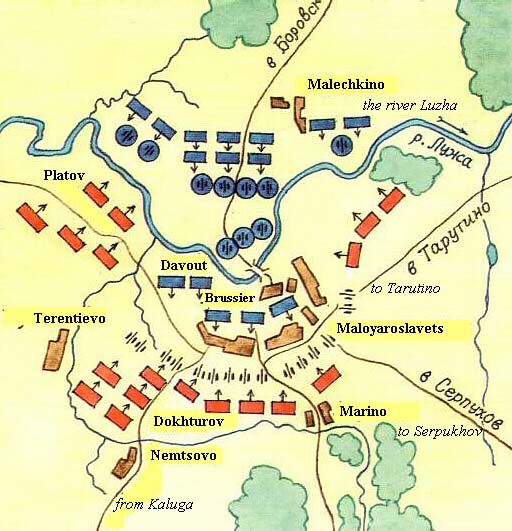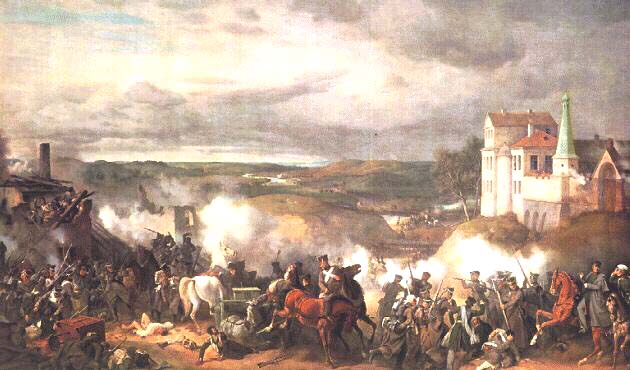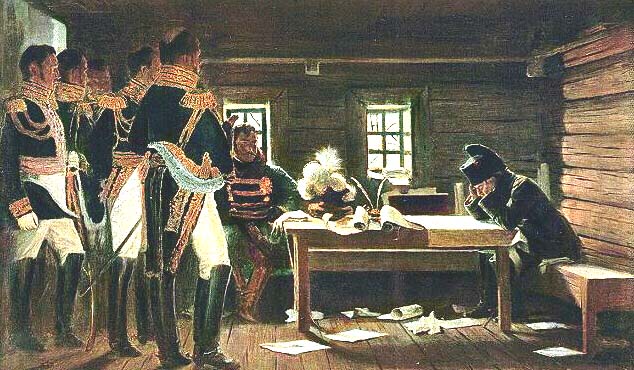October, 24 (October,12),1812
(From: Zhilin "The Patriotic War Of 1812", Moscow,1988;
E.V.Tarle, Complete Works, Volume VII., Moscow 1959)
 General Dmitry Dokhturov
General Dmitry Dokhturov(The portrait by Osipov) |
Kutuzov already had an eye on this direction (the region of Fominskoe village) for some time, and when his staff received the detailed report from General Dorokhov, they took drastic measures to ruin Napoleon's plan.
In just one day, October 23rd., the Russian Commander-in-Chief gave 16 written orders to his troops, plus many verbal orders. General P.N.Ivashev was ordered to urgently prepare the road from Letashovka village to Maloyaroslavets for movement of the army with artillery. He had to organize his troops in such a manner that there would be enough to cover two or three more roads. (1)
Sending cavalry, the most mobile part of his army, to intercept the movement of Napoleon's forces, Field-Marshal Kutuzov presented a task to Dokhturov's corps, in the village of Aristovo: they were to move by country roads, parallel with the enemy, and then attack; to finally clear up what was happening on the Old Kaluga road and determine if Murat and the Corps of Ney were actually there, General Miloradovich was ordered "To scout and define the real purpose and direction of the enemy vanguard movement". (2)
When the Russian Staff learned of the French moving from Voronovo to the Kaluga road, the entire Russian army set out for Maloyaroslavets. Such were the tactical maneuvers before the Maloyaroslavets battle.
The French striving for breaking through to Kaluga and to save their army; and the firm decision of the Russians not to let Napoleon pass to Kaluga by all means defined that stubborn character of fighting that developed on the streets of Maloyaroslavets.
Maloyaroslavets was a small town located 120 kilometers to the South from Moscow, it standed on the steep right bank of the river Luzha. The river formed an arc just near the town and covered it from the North. On the top of this arc there was a single bridge, that was a kind of the gate into the town.
Maloyaroslavets, as we know, interested Napoleon as a point on his path to Kaluga, Medyn and Yukhnov and on to Elnia and Smolensk. The Napoleonic army of 100 thousand stretched for several versts (1 verst= 3500 feet), with the Corps of Beauharnais in the vanguard.
On October 24th. at daybreak, the Russian troops of General Dokhturov approached Maloyaroslavets. They blocked the route to the Kaluga road and stopped the French vanguard. Dokhturov took excellent positions and his troops were able to defend themselves successfully, cover the main approaches to the town and fight for Maloyaroslavets.

The Maloyaroslavets Battle
About to dislodge two French battalions from the town. Dokhturov ordered General Dorokhov to detach three jager regiments from his troops and attack the enemy.
On the morning of the 23rd. the jager regiment met the French forces on the town streets, and successfully forced them from the town to the river. Marshal Beauharnais, who came to Maloyaroslavets with his staff. Then committed General Delsonne's entire division. Dokhturov reinforced his troops too with the 6th and 19th jager regiments, and the fierce fighting started again.
The battle for Maloyaroslavets was another blow to Napoleon. The Russian artillery batteries fired on the crossing and did serious damage to the French. Division commander Delsonne was killed. Brigade General Gillemino, who took over the command, burst into the town using his numerical superiority and reoccupied it. Then Brussier's Division entered Maloyaroslavets and prepared to attack the Russian positions a half kilometer away.
But the Russians reinforced their units too. The Libavsky and Sophiysky infantry regiments joined the action. Supported by strong artillery fire they rushed to the attack. Hot and stubborn fighting developed in the streets. Fires were started all over town. Beauharnais pushed the 3rd. Division forward, and later, at noon, the troops of Davout's Corps and the Guards arrived. The battle became even more violent.

The Maloyaroslavets Battle
(The picture by Hess)
On October 24th. the main Russian forces were still marching 5 kilometers from Maloyaroslavets. After receiving the report that the battle had begun, Kutuzov sent the 7th Corps of General Raevsky to join battle as soon as they arrived.
At 3 p.m. the town was almost cleared of French troops. But Napoleon came to the battleground and sent two Divisions from Marshal Davout's corps to the aid to of Beauharnais. They made a bridge over the Luzha river and burst yet again into the town, joining the other French troops. The town was once again French.
That same afternoon, the general forces of the Russian army arrived from Tarutino. They took positions on both sides of the Kaluga road.
The violent fighting for the town continued. Kutuzov at once came to his fighting men.
Napoleon heard that the main Russian forces had come to Maloyaroslavets and told his Marshals, that the situation had changed radically. (3) He realized the road to Kaluga was now closed to him.
When darkness fell, the battle calmed. The whole town was enveloped in flames, its streets heaped with dead bodies. The French had lost about 5 thousand men. The Russian losses were near 3 thousand.
Though both armies were still face to face, Kutuzov was sure of his victory, because his main goal; to concentrate his army on Napoleon's retreat route, had been achieved. At last the main struggle was just for the paths to Kaluga. It became especially clear the next day near Medyn, when the Cossack troops of Ataman Platov ran into the Corps of Poniatowsky that was trying to break through to Kaluga on a roundabout path.

The War Council in Gorodnia
(from the picture by Vereschagin)
Napoleon was very much dissatisfied with the results of the battle. At night, when he returned to the village Gorodnia, he took council with his Marshals, discussing only one subject: would they engage in a general battle tomorrow or avoid it?
At daybreak on October 25th. Napoleon went to Maloyaroslavets to inspect the place of battle. On the way, he was nearly captured by Platov's Cossacks who had crossed the river during the night to attack the enemy's rear. Napoleon had only a small retinue with him: Marshal Bertier, General Rapp and some officers.
Suddenly they saw a detachment of cossacks rushing towards them, full speed, with lances atilt and loud cries - "Hurra!".
These cries saved Napoleon from certain death or capture as his retinue first took them for a squadron of French cavalry. Only the cries of the cossacks warned them what was really happening. About 25 men from Napoleon's retinue crowded around him. One Cossack rushed at Rapp, lancing his horse, but just in time two French cavalry squadrons arrived. The cossacks turned back and charged to a different part of the French camp, then, taking some French horses and artillery with them, hid in the forest.
Napoleon finally arrived at Maloyaroslavets. The sight was devastating: the town was in ruins, and there were thousands of charred dead bodies - bodies of the town inhabitants, and Russian and French wounded soldiers, burnt alive by the enveloping fires. Some fires were still burning.
Napoleon came back to Gorodnia and that evening gave the order to turn back to the Old Kaluga road, to where they had started, days earlier. He was badly shaken by the raid of cossacks and that same evening sent for doctor Juvanne and ordered him to at once prepair and give him a bottle of poison. The Emperor never parted with that bottle though he was not threatened again capture.
Kutuzov appraised the situation and feared being turned by the French though the village of Medyn. So he left two infantry and two cavalry Corps under the command of General Miloradovich at Maloyaroslavets and moved his main forces to the village of Detchino from where it was possible to act against Napoleon in any direction.
These counter-measures taken by Kutuzov not only blocked all roads for the French, they also neutralized the enemy forces. Besides, the bloody combat at Maloyaroslavets finally wrested the offensive initiative from the French. Napoleon was forced to turn his troops towards Bobruysk, Verea and Mozhaisk; retreating along the Smolensk road. The Russians forced the French army to retreat through the very regions the French had ravaged before.
The battle at Maloyaroslavets was the culmination of the struggle for strategic initiative. It ranks near the top in the History of the Patriotic War of 1812. Its results determined the further course of the war and decidedly forecast the fate of the Napoleonic army. The importance of this bloody battle was perfectly clear to the commanders of both armies.
- The Patriotic War Of 1812 . Materials of VUA, Volume 19,p.130
- The same , p.128
- The Collection Of Historical Materials Taken From The Office Of His Imperial Majesty. St.Petesburg, 1898, issue 10, page 76